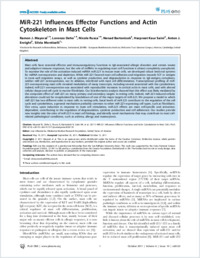MiR-221 influences effector functions and actin cytoskeleton in mast cells
- Mayoral, Ramon J. Institute for Research in Biomedicine (IRB), Faculty of Biomedical Sciences, Università della Svizzera italiana, Switzerland
- Deho, Lorenzo Institute for Research in Biomedicine (IRB), Faculty of Biomedical Sciences, Università della Svizzera italiana, Switzerland
- Rusca, Nicole Institute for Research in Biomedicine (IRB), Faculty of Biomedical Sciences, Università della Svizzera italiana, Switzerland
- Bartonicek, Nenad EMBL - European Bioinformatics Institute, Wellcome Trust Genome Campus, Hinxton, Cambridge, United Kingdom
- Saini, Harpreet Kaur EMBL - European Bioinformatics Institute, Wellcome Trust Genome Campus, Hinxton, Cambridge, United Kingdom
- Enright, Anton J. EMBL - European Bioinformatics Institute, Wellcome Trust Genome Campus, Hinxton, Cambridge, United Kingdom
- Monticelli, Silvia Institute for Research in Biomedicine (IRB), Faculty of Biomedical Sciences, Università della Svizzera italiana, Switzerland
-
12.10.2011
Published in:
- Plos one. - 2011, vol. 6, no. 10, p. e26133
English
Mast cells have essential effector and immunoregulatory functions in IgE-associated allergic disorders and certain innate and adaptive immune responses, but the role of miRNAs in regulating mast cell functions is almost completely unexplored. To examine the role of the activation-induced miRNA miR-221 in mouse mast cells, we developed robust lentiviral systems for miRNA overexpression and depletion. While miR-221 favored mast cell adhesion and migration towards SCF or antigen in trans-well migration assays, as well as cytokine production and degranulation in response to IgE-antigen complexes, neither miR-221 overexpression, nor its ablation, interfered with mast cell differentiation. Transcriptional profiling of miR-221-overexpressing mast cells revealed modulation of many transcripts, including several associated with the cytoskeleton; indeed, miR-221 overexpression was associated with reproducible increases in cortical actin in mast cells, and with altered cellular shape and cell cycle in murine fibroblasts. Our bioinformatics analysis showed that this effect was likely mediated by the composite effect of miR-221 on many primary and secondary targets in resting cells. Indeed, miR- 221-induced cellular alterations could not be recapitulated by knockdown of one of the major targets of miR-221. We propose a model in which miR-221 has two different roles in mast cells: in resting cells, basal levels of miR-221 contribute to the regulation of the cell cycle and cytoskeleton, a general mechanism probably common to other miR-221- expressing cell types, such as fibroblasts. Vice versa, upon induction in response to mast cell stimulation, miR-221 effects are mast cell-specific and activation-dependent, contributing to the regulation of degranulation, cytokine production and cell adherence. Our studies provide new insights into the roles of miR-221 in mast cell biology, and identify novel mechanisms that may contribute to mast cell-related pathological conditions, such as asthma, allergy and mastocytosis.
- Language
-
- English
- Classification
- Medicine
- License
- Open access status
- gold
- Identifiers
-
- RERO DOC 326683
- DOI 10.1371/journal.pone.0026133
- ARK ark:/12658/srd1319041
- Persistent URL
- https://n2t.net/ark:/12658/srd1319041
Statistics
Document views: 159
File downloads:
- Texte intégral: 160
